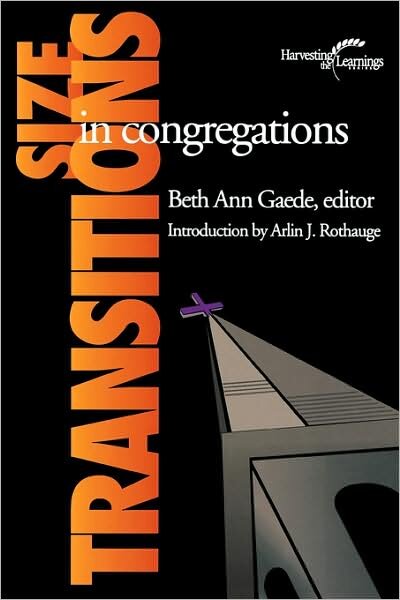Beth Ann Gaede, Editor, Size Transitions in Congregations. Alban Institute, 2001.
Referenced in: Church Leadership – Size Dynamics and Transitions
LifeandLeadership Summary
This is one of Alban Institute’s contributions to the issue of congregational size transitions. Other volumes include Alice Mann’s The In-Between Church: Navigating Size Transitions and Mann’s more focused look at the one of the more difficult size transitions, i.e. from pastoral (50-150) to program (151-400), in Raising the Roof: The Pastoral-to-Program Size Transition. Alban’s materials on this subject are more useful for smaller or mid-size churches.
This text reflects the best thought among mainline denominations relative to size transitions. The opening chapter by Theodore Johnson builds upon the seminal research by Arlin Rothauge, Sizing Up a Congregation for New Member Ministry (1986) which argued that effective evangelistic churches are those who carry out new member ministry according to the size of the congregation. Thus a family church (up to 50) evangelizes the way a family does – by birth, marriage, and adoption. Pastoral churches (51-150) grow almost exclusively on the relationship the newcomers develop with the pastor. Program churches (151-350) grow as people are attracted by their programs. Corporation churches (351+) grow by drawing newcomers to its human, financial, and physical resources for high quality ministries.
While most who used Rothauge completely ignored, misunderstood, or misapplied his evangelistic intent, his brief, ground-breaking book had a revolutionary impact in helping church leaders understand four distinctive congregational cultures wherein the size defines the leadership structure and relational style. Rothauge’s typologies continue to be adopted by some while many others have produced their own typologies (e.g. see Schaller and McIntosh). This text uses Rothauge with some caveat and modifications. For example, Doug Walrath (62-63) offers a typology of five sizes based membership/attendance ranging from 75/50 to 800/350. They combine this with anthropological research on group size as the building blocks of congregations (cf. Malcolm Gladwell, The Tipping Point) – small/sympathy groups (15 or less), primary/family groups (50 or less), and community/village/fellowship groups (less than 150). Some congregations have only one of these building blocks and some have several in a complex formation, depending on size. These insights help one understand that congregational
size transitions require more than basic church growth techniques, because when a congregation transitions in size, it must change the culture of the congregation, often contrary to the preference of many existing members who are satisfied with the current relational style and leadership structure. Size transitions are far more complicated than many believe and are often filled with pain, resistance, outright sabotage, and inevitable membership disruption. (25)
Based on this understanding, authors such as Theodore Johnson, Roy Oswald, Alice Mann, Douglas Walrath, and others present what is perhaps the best sociology of congregations based on size. Chapters include how to minister effectively in all four types, navigating the developmental issues in the six possible transitions between sizes, how to size up a congregation, building mutually satisfying leader relationships, enduring growing pains, transitioning to program size and corporation size, as well as helping congregations in decline or even death/dying.
This is a valuable text. Some of the material, Roy Oswald’s chapter on ministering to churches of various sizes (ch. 2) and Alice Mann’s chapter of what happens between sizes (ch. 3) are repeats of information in The In-Between Church, but there is enough unique information in chapters 1, 4-5, 8 and 10-15 to merit a separate read.
From the Publisher
Congregations that seek growth are often frustrated at hitting a plateau caught in a transition zone between sizes. The Alban Institute has long been recognized as a leader in size transition research and learning, and this anthology offers an in-depth collection of resources, through new articles developed for the book as well as previously published and highly regarded pieces that inform and provoke.
In a new essay, Arlin Rothauge, director of the Seabury Institute and author of Sizing Up a Congregation for New Member Ministry, a classic on the subject, offers his reflections on the state of the research and the models that have been used to frame discussion about size transitions. Alban senior consultant Alice Mann describes key findings from her current research on the pastoral-to-program size transition, perhaps the most common and most difficult to address. Other new material focuses on size transition in synagogues; the program-to-corporate transition; and the “awkward size” congregation with the resources of a pastor-centered congregation, but the desire to be program size.
About the Author
Beth Ann Gaede has been an editor with the Alban Institute since 1995. A pastor of the Evangelical Lutheran Church in America, she works as a freelance editor and writer for a variety of church-related publishers.
***For additional information on this resource, including reviews, click the bookstore links. Check the reference at page top or the links below for resource guides on related topics.***
See Resources on Over 100 Areas of Ministry Leadership:


